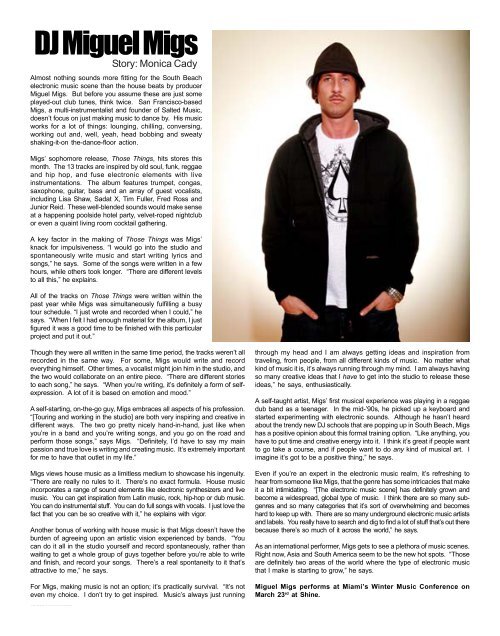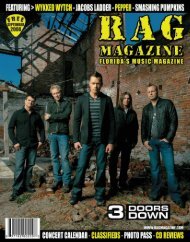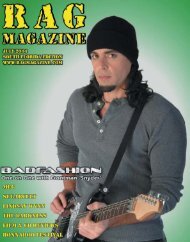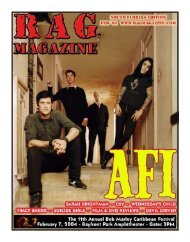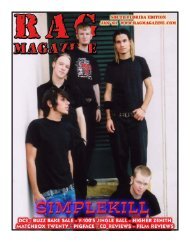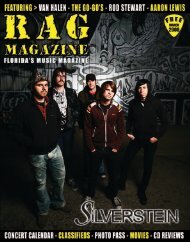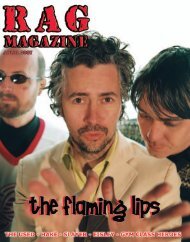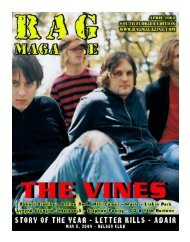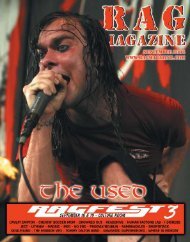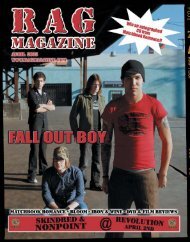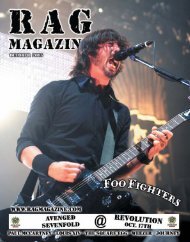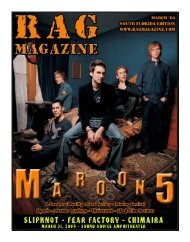03/07 - RAG Magazine
03/07 - RAG Magazine
03/07 - RAG Magazine
You also want an ePaper? Increase the reach of your titles
YUMPU automatically turns print PDFs into web optimized ePapers that Google loves.
DJ Miguel MigsStory: Monica CadyAlmost nothing sounds more fitting for the South Beachelectronic music scene than the house beats by producerMiguel Migs. But before you assume these are just someplayed-out club tunes, think twice. San Francisco-basedMigs, a multi-instrumentalist and founder of Salted Music,doesn’t focus on just making music to dance by. His musicworks for a lot of things: lounging, chilling, conversing,working out and, well, yeah, head bobbing and sweatyshaking-it-on the-dance-floor action.Migs’ sophomore release, Those Things, hits stores thismonth. The 13 tracks are inspired by old soul, funk, reggaeand hip hop, and fuse electronic elements with liveinstrumentations. The album features trumpet, congas,saxophone, guitar, bass and an array of guest vocalists,including Lisa Shaw, Sadat X, Tim Fuller, Fred Ross andJunior Reid. These well-blended sounds would make senseat a happening poolside hotel party, velvet-roped nightclubor even a quaint living room cocktail gathering.A key factor in the making of Those Things was Migs’knack for impulsiveness. “I would go into the studio andspontaneously write music and start writing lyrics andsongs,” he says. Some of the songs were written in a fewhours, while others took longer. “There are different levelsto all this,” he explains.All of the tracks on Those Things were written within thepast year while Migs was simultaneously fulfilling a busytour schedule. “I just wrote and recorded when I could,” hesays. “When I felt I had enough material for the album, I justfigured it was a good time to be finished with this particularproject and put it out.”Though they were all written in the same time period, the tracks weren’t allrecorded in the same way. For some, Migs would write and recordeverything himself. Other times, a vocalist might join him in the studio, andthe two would collaborate on an entire piece. “There are different storiesto each song,” he says. “When you’re writing, it’s definitely a form of selfexpression.A lot of it is based on emotion and mood.”A self-starting, on-the-go guy, Migs embraces all aspects of his profession.“[Touring and working in the studio] are both very inspiring and creative indifferent ways. The two go pretty nicely hand-in-hand, just like whenyou’re in a band and you’re writing songs, and you go on the road andperform those songs,” says Migs. “Definitely, I’d have to say my mainpassion and true love is writing and creating music. It’s extremely importantfor me to have that outlet in my life.”Migs views house music as a limitless medium to showcase his ingenuity.“There are really no rules to it. There’s no exact formula. House musicincorporates a range of sound elements like electronic synthesizers and livemusic. You can get inspiration from Latin music, rock, hip-hop or dub music.You can do instrumental stuff. You can do full songs with vocals. I just love thefact that you can be so creative with it,” he explains with vigor.Another bonus of working with house music is that Migs doesn’t have theburden of agreeing upon an artistic vision experienced by bands. “Youcan do it all in the studio yourself and record spontaneously, rather thanwaiting to get a whole group of guys together before you’re able to writeand finish, and record your songs. There’s a real spontaneity to it that’sattractive to me,” he says.For Migs, making music is not an option; it’s practically survival. “It’s noteven my choice. I don’t try to get inspired. Music’s always just runningthrough my head and I am always getting ideas and inspiration fromtraveling, from people, from all different kinds of music. No matter whatkind of music it is, it’s always running through my mind. I am always havingso many creative ideas that I have to get into the studio to release theseideas,” he says, enthusiastically.A self-taught artist, Migs’ first musical experience was playing in a reggaedub band as a teenager. In the mid-’90s, he picked up a keyboard andstarted experimenting with electronic sounds. Although he hasn’t heardabout the trendy new DJ schools that are popping up in South Beach, Migshas a positive opinion about this formal training option. “Like anything, youhave to put time and creative energy into it. I think it’s great if people wantto go take a course, and if people want to do any kind of musical art. Iimagine it’s got to be a positive thing,” he says.Even if you’re an expert in the electronic music realm, it’s refreshing tohear from someone like Migs, that the genre has some intricacies that makeit a bit intimidating. “[The electronic music scene] has definitely grown andbecome a widespread, global type of music. I think there are so many subgenresand so many categories that it’s sort of overwhelming and becomeshard to keep up with. There are so many underground electronic music artistsand labels. You really have to search and dig to find a lot of stuff that’s out therebecause there’s so much of it across the world,” he says.As an international performer, Migs gets to see a plethora of music scenes.Right now, Asia and South America seem to be the new hot spots. “Thoseare definitely two areas of the world where the type of electronic musicthat I make is starting to grow,” he says.Miguel Migs performs at Miami’s Winter Music Conference onMarch 23 rd at Shine.40| DEC <strong>RAG</strong> MAGAZINE


